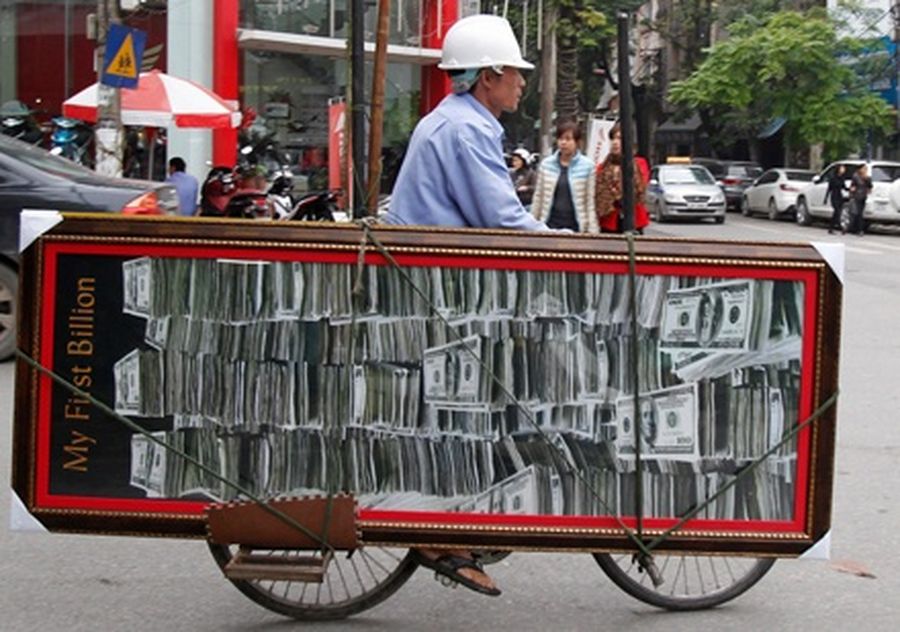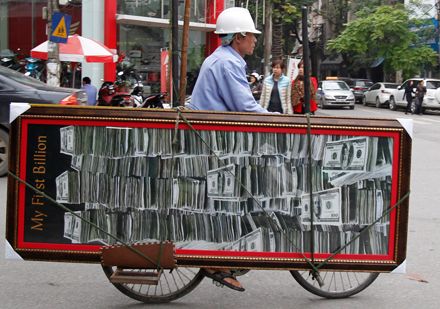
Source: REUTERS/Kham
A man carries a billboard with an image of US-dollar notes as he rides a bicycle on a street in Hanoi.
Many dollar-denominated bonds that South-East Asian companies issued in 2009 and 2010 will become callable this year, meaning a flurry of debt exchanges and liability-management exercises is on the way. High-yield names will be especially prevalent.
Beyond five-year non-call three bonds, issued in 2009 and 2010, becoming callable, bankers said the main reason for the expected pick-up in liability-management activities was the current yields on junk bonds. The average yield-to-worst on the Bank of America Merrill Lynch Single B and Double B corporate index is 4.9%, one of its lowest levels in history.
“Many companies, which issued in 2009 and 2010, can now get new money for 200bp, even 300bp, less,” said a liability-management banker in Singapore. “You can now get wonderful coupons and lower a lot the average yield in the debt portfolio of these high-yield companies.”
There are at least 20 high-yield companies from South-East Asia with bonds callable this year, according to data from Thomson Reuters. However, te potential universe of companies in the region willing to exchange their high-coupon bonds is much larger. The problem is getting investors to let go of paper that features a high carry to buy new, longer bonds that yield less. That is why bankers are focusing mostly on the issuers with callable bonds.
Little option
So far, most companies with options to replace outstanding high-coupon bonds with lower-yielding ones have done so in a friendly manner and at least given investors the option of an exchange. In the first week of March, Ba1/BB rated Singapore chipmaker Stats ChipPAC, for instance, exchanged its 7.5% five-year bonds issued in August 2010, which were callable this year. The participants in the exchange received new five-year bonds with a 4.5% coupon, meaning the company managed to achieve a three-year extension to the maturity and 300bp reduction in the cost of its debt.
Investors had little option, but participate. Those that opted out of the exchange would have had to hand over their bonds by August and, if they wanted to regain exposure, the would have had to buy the bonds in the secondary. Most investors participated, even though the carry on the new securities is much less attractive. “We actually gave investors a favourable route with the exchange,” said a person close to the deal, for which Credit Suisse and Deutsche Bank were leads.
Stats ChipPAC, however, was not the first to spot the possibility of replacing higher coupon bonds with cheaper ones. Leading the way there were Indonesian companies. Last year, Indonesia’s Cikarang Listrindo restructured a US$300m amortiser due in 2015 as a ne seven-year fixed-rate bond. Other Indonesian companies, including B1/BB /BB rated developer Lippo Karawaci and, more recently, B2/B rated tyre-maker Gajah Tunggal did the same.
Right now, Gajah Tunggal, more than any other issuer, perhaps, shows the advantage replacing high coupon bonds with lower-yielding ones. The company forcefully restructured its dollar bonds in 2009, issuing new 10% 2014 paper. In January, it called those bonds and issued US$500m of new five-year paper at a yield of 7.95% on a coupon of 7.75%. The deal was 7.5x oversubscribed, showing that investors were keen to buy bonds even at a lower coupon.
More importantly, the refinancing removed the restructured bonds from the market and, as a result, changed investor perception of the company. Moody’s upgraded the company right after the liability management exercise, while Standard & Poor’s put it on positive outlook.
The results were not lost on other issuers in South-East Asia with Indonesian names again leading the charge. Among those heard to be working on liability-management trades are ABM Investama, which mandated Goldman Sachs and Morgan Stanley last year for a new bond to replace a maturing one, and Medco Energi, which had mandated JP Morgan, DBS, UBS, Standard Chartered and Credit Suisse for the same reason.
“As these companies issued bonds three to four years ago in a much different environment, it makes sense for them to come,” said a syndicate banker.
Bankers said that some Indonesian and Filipino companies were looking to tap the bond market to refinance maturing loans, too. “Dollar bonds are still cheaper than loans for high-yield issuers”, especially with the higher capital requirements for junk-rated loans under new Basel rules, said the liability-management banker.
In short, the message is clear for holders of high-coupon South-East Asian bonds enjoy the carry while you can; soon enough, the bonds will be called and replaced for lower-yielding ones.
To see the digital version of this report, please click here.
